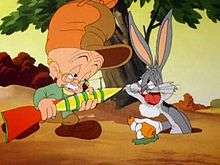The Old Grey Hare
| The Old Grey Hare | |
|---|---|
| Merrie Melodies (Bugs Bunny/Elmer Fudd) series | |
 Original title card | |
| Directed by | Robert Clampett |
| Produced by | Eddie Selzer (uncredited) |
| Story by | Michael Sasanoff |
| Voices by |
Mel Blanc Arthur Q. Bryan "'Uncredited"' |
| Music by | Carl W. Stalling |
| Animation by |
Robert McKimson Rod Scribner Manny Gould Basil Davidovich Thomas McKimson A. C. Gamer (effects animation) |
| Backgrounds by | Dorcy Howard |
| Studio | Warner Bros. Cartoons, Inc. |
| Distributed by |
Warner Bros. Pictures The Vitaphone Corporation |
| Release date(s) | October 28, 1944 (U.S.) |
| Color process | Technicolor |
| Running time | 7 minutes 36 seconds |
| Language | English |
| Preceded by | Buckaroo Bugs |
| Followed by | Stage Door Cartoon |
The Old Grey Hare is a 1944 Warner Bros. cartoon in the Merrie Melodies series, directed by Bob Clampett, written by Michael Sasanoff, music by Carl W. Stalling. Starring an older and young Bugs Bunny and Elmer Fudd. This was the first time the Bugs Bunny cartoon credited Warner Bros. Cartoons as producer after Leon Schlesinger had sold the studio to WB (because Edward Selzer refused to receive on-screen credit as producer).
The title is a double play on words. One is the typical pun between "hare" and "hair", with the bunny (who was already grey-haired) rendered "old and grey" for this cartoon. The title also refers to the old song, "The Old Gray Mare". Some of the lobby cards for this cartoon gave the alternate spelling, The Old Gray Hare.
Plot synopsis

The cartoon starts with Elmer sitting under a tree, crying over his failure to catch Bugs. The "voice of God" (also the voice of Mel Blanc) tells Elmer to keep trying to catch him. Elmer wonders how long it will it take- and is shown exactly how long by being transported "far into the future" past the years 1950, 1960, 1970, 1980, 1990, until reaching the then-distant year of 2000 A.D..
This offers the chance to use some contemporary gags with a futuristic twist, as Elmer finds a year 2000 newspaper. One headline says, "Smellevision Replaces Television: Carl Stalling Sez It Will Never Work!" In sporting news, another headline says, "Bing Crosby's Horse Hasn't Come In Yet!" (Crosby was known for investing in racehorses that did poorly).
By now, both Elmer and Bugs are very old and wrinkled ("What's up, prune-face?") - Bugs even has a large white beard and a cane - and lumbago - but their chase resumes. This time Elmer is armed with a "Buck Rogers" ray gun. After a short chase (at slow speed, due to their ages), Elmer gets the upper hand, shooting Bugs with his ultra-modern weapon.
At the moment when it seems Elmer has finally beaten his nemesis, the apparently dying Bugs thinks back to when he and Elmer were much younger. This leads to a flashback sequence with a baby Elmer hunting a baby Bugs (both are still in diapers; Bugs is drinking carrot juice from a baby bottle; Elmer is crawling and toting a pop-gun; and they interrupt their chase to take a baby nap-time together).
After the flashback is over, a tearful Bugs starts to dig his own grave, with Elmer getting equally emotional (while literally sobbing along to the tune of "Träumerei" by Robert Schumann). Just at the point where it seems that Bugs is going to bury himself, he switches places with the weeping and distracted Elmer, and cheerfully buries him alive instead ("So long, Methuselah!") The buried Elmer quips, "Weww anyway, that pesky wabbit is out of my wife [life] fowevew and evew!" However, Bugs suddenly pops in and repeats the popular catchphrase of the "Richard Q. Peavey" character from The Great Gildersleeve, "Well, now, I wouldn't say that," plants a kiss on Elmer, then hands him a large firecracker and lights the fuse, and quickly departs. While Elmer shivers and doesn't do anything, he gives out a long, horrifying shriek as the screen immediately fades out and Robert Clampett's famous vocalized "Bay-woop!" is heard with the firecracker still hissing. The ending "That's all, Folks!" card appears with it having been already pre-written, and the firecracker blows up in a tremendous explosion off-screen, rumbling and shaking the on-screen end title card, regardless of what happened to Elmer after the explosion.
Availability
- The short is available in its entirety (with the shaking end card) in the documentary Bugs Bunny: Superstar Part 2, which is available as a special feature on Disc 2 of the Looney Tunes Golden Collection: Volume 4, and was released independently on the Looney Tunes Golden Collection: Volume 5 and on Blu-ray in 1080p high definition on the Looney Tunes Platinum Collection: Volume 1.
See also
External links
| Preceded by Buckaroo Bugs |
Bugs Bunny Cartoons 1944 |
Succeeded by Stage Door Cartoon |